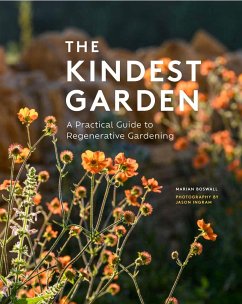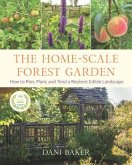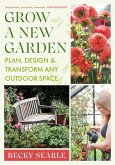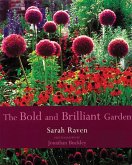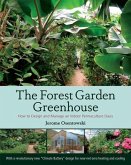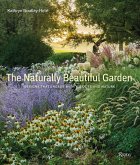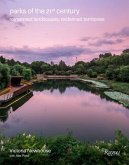- Gebundenes Buch
- Merkliste
- Auf die Merkliste
- Bewerten Bewerten
- Teilen
- Produkt teilen
- Produkterinnerung
- Produkterinnerung
Learn how to garden for the planet with The Kindest Garden, an innovative guide to regenerative gardening from leading landscape designer Marian Boswall.
Andere Kunden interessierten sich auch für
![The Home-Scale Forest Garden The Home-Scale Forest Garden]() Dani BakerThe Home-Scale Forest Garden27,99 €
Dani BakerThe Home-Scale Forest Garden27,99 €![Grow a New Garden Grow a New Garden]() Becky SearleGrow a New Garden26,99 €
Becky SearleGrow a New Garden26,99 €![The Bold & Brilliant Garden The Bold & Brilliant Garden]() Sarah RavenThe Bold & Brilliant Garden23,99 €
Sarah RavenThe Bold & Brilliant Garden23,99 €![The Forest Garden Greenhouse The Forest Garden Greenhouse]() Jerome OsentowskiThe Forest Garden Greenhouse41,99 €
Jerome OsentowskiThe Forest Garden Greenhouse41,99 €![The Naturally Beautiful Garden The Naturally Beautiful Garden]() Kathryn Bradley-HoleThe Naturally Beautiful Garden15,99 €
Kathryn Bradley-HoleThe Naturally Beautiful Garden15,99 €![Rainwater Harvesting for Drylands and Beyond, Volume 1, 3rd Edition Rainwater Harvesting for Drylands and Beyond, Volume 1, 3rd Edition]() Brad LancasterRainwater Harvesting for Drylands and Beyond, Volume 1, 3rd Edition29,99 €
Brad LancasterRainwater Harvesting for Drylands and Beyond, Volume 1, 3rd Edition29,99 €![Parks of the 21st Century Parks of the 21st Century]() Victoria NewhouseParks of the 21st Century55,99 €
Victoria NewhouseParks of the 21st Century55,99 €-
-
-
Learn how to garden for the planet with The Kindest Garden, an innovative guide to regenerative gardening from leading landscape designer Marian Boswall.
Produktdetails
- Produktdetails
- Verlag: Quarto Publishing PLC
- Seitenzahl: 240
- Erscheinungstermin: 8. April 2025
- Englisch
- Abmessung: 246mm x 198mm x 23mm
- Gewicht: 896g
- ISBN-13: 9780711289437
- ISBN-10: 0711289433
- Artikelnr.: 70945663
- Herstellerkennzeichnung
- Libri GmbH
- Europaallee 1
- 36244 Bad Hersfeld
- gpsr@libri.de
- Verlag: Quarto Publishing PLC
- Seitenzahl: 240
- Erscheinungstermin: 8. April 2025
- Englisch
- Abmessung: 246mm x 198mm x 23mm
- Gewicht: 896g
- ISBN-13: 9780711289437
- ISBN-10: 0711289433
- Artikelnr.: 70945663
- Herstellerkennzeichnung
- Libri GmbH
- Europaallee 1
- 36244 Bad Hersfeld
- gpsr@libri.de
Marian Boswall is a leading landscape architect and horticulturalist, was a lecturer in Historic Garden Conservation at Greenwich University for several years and is a co-founder of the Sustainable Landscape Foundation. Her projects invest in the land for the very long term and wellness is a deeply embedded ethos: Marian works with the way the land can heal and connect us on all levels; in early 2020 she gave a TedX talk on how our gardens can care for us and the earth. Marian writes and lectures on sustainable design and was awarded the Garden Columnist of the Year in 2019. She has also been featured as a Country Life ‘Top 50’ Garden Designer, House & Garden ‘Top 50’ UK Garden Designer and Country and Town House ‘Top 10’ Garden Designer. JASON INGRAM is an award-winning garden and food photographer. He is based in Bristol, UK, and travels widely photographing gardens, plants, food and people for magazines, books and advertising.
What is regenerative gardening?
Taking inspiration from large-scale regenerative projects
Practising kindness
Top ten insights for regenerative gardeners
How to use this book
PART ONE: RELATIONSHIPS –THE ELEMENTS OF THE GARDEN
SOIL: WHAT I S IT?
Taking inspiration from the soil network
Weeds
WATER: HOW DOES THE WATER CYCLE WORK?
Wetland regeneration: what we can learn from large-scale projects
Water in our gardens
ECOSYSTEMS: THE NETWORK OF LIFE
Understanding garden ecosystems
Creating a haven: a practical guide to planning an ecosystem garden
MATERIALS: HOW TO CHOOSE MATERIALS TO WORK WITH
Understanding materials for gardens and landscapes
ENERGY: RENWABLE ENERGY
How to work with natural energy
How to work with land energy
RESILIENT PLANTING
Inpsiration for our gardens: large-scale woodlands
Meadows
Prairie planting
Mediterranean planting
Establishment and management
PART TWO: MEASURING OUR IMPACT
WHY SHOULD WE MEAUSURE OUR IMPACT?
What can we assess in our own gardens?
PART THREE: CONNECTION – THE KINDEST GARDEN
OUR NEED FOR CONNECTION
How gardening for nature can be gardening for ourselves
How to build community through gardening
Reconnecting with ourselves
Sharing knowledge: a final note
Appendix 1: Comparison of pond liners
Appendix 2: Grey water recycling
Resources and further information
Index
Acknowledgements
Taking inspiration from large-scale regenerative projects
Practising kindness
Top ten insights for regenerative gardeners
How to use this book
PART ONE: RELATIONSHIPS –THE ELEMENTS OF THE GARDEN
SOIL: WHAT I S IT?
Taking inspiration from the soil network
Weeds
WATER: HOW DOES THE WATER CYCLE WORK?
Wetland regeneration: what we can learn from large-scale projects
Water in our gardens
ECOSYSTEMS: THE NETWORK OF LIFE
Understanding garden ecosystems
Creating a haven: a practical guide to planning an ecosystem garden
MATERIALS: HOW TO CHOOSE MATERIALS TO WORK WITH
Understanding materials for gardens and landscapes
ENERGY: RENWABLE ENERGY
How to work with natural energy
How to work with land energy
RESILIENT PLANTING
Inpsiration for our gardens: large-scale woodlands
Meadows
Prairie planting
Mediterranean planting
Establishment and management
PART TWO: MEASURING OUR IMPACT
WHY SHOULD WE MEAUSURE OUR IMPACT?
What can we assess in our own gardens?
PART THREE: CONNECTION – THE KINDEST GARDEN
OUR NEED FOR CONNECTION
How gardening for nature can be gardening for ourselves
How to build community through gardening
Reconnecting with ourselves
Sharing knowledge: a final note
Appendix 1: Comparison of pond liners
Appendix 2: Grey water recycling
Resources and further information
Index
Acknowledgements
What is regenerative gardening?
Taking inspiration from large-scale regenerative projects
Practising kindness
Top ten insights for regenerative gardeners
How to use this book
PART ONE: RELATIONSHIPS –THE ELEMENTS OF THE GARDEN
SOIL: WHAT I S IT?
Taking inspiration from the soil network
Weeds
WATER: HOW DOES THE WATER CYCLE WORK?
Wetland regeneration: what we can learn from large-scale projects
Water in our gardens
ECOSYSTEMS: THE NETWORK OF LIFE
Understanding garden ecosystems
Creating a haven: a practical guide to planning an ecosystem garden
MATERIALS: HOW TO CHOOSE MATERIALS TO WORK WITH
Understanding materials for gardens and landscapes
ENERGY: RENWABLE ENERGY
How to work with natural energy
How to work with land energy
RESILIENT PLANTING
Inpsiration for our gardens: large-scale woodlands
Meadows
Prairie planting
Mediterranean planting
Establishment and management
PART TWO: MEASURING OUR IMPACT
WHY SHOULD WE MEAUSURE OUR IMPACT?
What can we assess in our own gardens?
PART THREE: CONNECTION – THE KINDEST GARDEN
OUR NEED FOR CONNECTION
How gardening for nature can be gardening for ourselves
How to build community through gardening
Reconnecting with ourselves
Sharing knowledge: a final note
Appendix 1: Comparison of pond liners
Appendix 2: Grey water recycling
Resources and further information
Index
Acknowledgements
Taking inspiration from large-scale regenerative projects
Practising kindness
Top ten insights for regenerative gardeners
How to use this book
PART ONE: RELATIONSHIPS –THE ELEMENTS OF THE GARDEN
SOIL: WHAT I S IT?
Taking inspiration from the soil network
Weeds
WATER: HOW DOES THE WATER CYCLE WORK?
Wetland regeneration: what we can learn from large-scale projects
Water in our gardens
ECOSYSTEMS: THE NETWORK OF LIFE
Understanding garden ecosystems
Creating a haven: a practical guide to planning an ecosystem garden
MATERIALS: HOW TO CHOOSE MATERIALS TO WORK WITH
Understanding materials for gardens and landscapes
ENERGY: RENWABLE ENERGY
How to work with natural energy
How to work with land energy
RESILIENT PLANTING
Inpsiration for our gardens: large-scale woodlands
Meadows
Prairie planting
Mediterranean planting
Establishment and management
PART TWO: MEASURING OUR IMPACT
WHY SHOULD WE MEAUSURE OUR IMPACT?
What can we assess in our own gardens?
PART THREE: CONNECTION – THE KINDEST GARDEN
OUR NEED FOR CONNECTION
How gardening for nature can be gardening for ourselves
How to build community through gardening
Reconnecting with ourselves
Sharing knowledge: a final note
Appendix 1: Comparison of pond liners
Appendix 2: Grey water recycling
Resources and further information
Index
Acknowledgements

